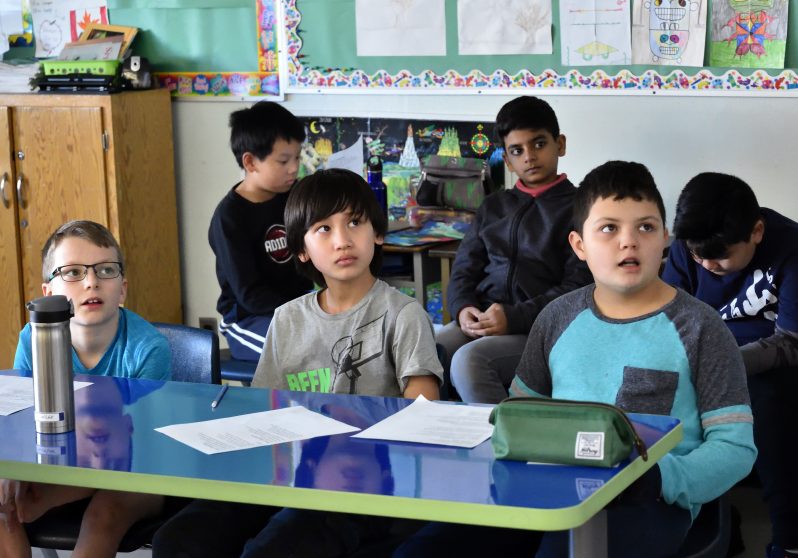Manoah Steves Elementary: The Voice of Human Rights
Thursday November 7th, 2019

Overview:
This project examined the contexts of human rights violations and advocacy both locally within Canada and through a global lens. In this inquiry, students worked towards exploring the complexity of current and historical events and the interrelationship between these events and humans. Students engaged in a process of understanding how human rights affect every aspect of our lives and how access to human rights impacts not only the individual, but the group. Students explored how the themes of this project are communicated through interdisciplinary means, and the relationship of the arts with scientific and mathematical principles.
Connection to the Vancouver Biennale Exhibition:
Students visited Paradise Has Many Gates by Ajlan Gharem. They used mindfulness that was developed through weekly outdoor education and regular viewing of images in the classroom, and applied the mathematic and artistic principles learned (use of colour, shape, and materials) throughout the year to somatically experience, reflect, and analyze this piece of work. Students also visited the Steveston Museum to learn about Japanese Internment, and the Musqueam Teaching Kit: Giving Information About Our Teachings to provide insight into the experiences of local First Peoples, was also used. Through these experiences, including discussion and written reflection, connections were made to different historical events, human rights and current worldviews. Further, this experience encouraged empathy in the students, as well as helped the students understand and appreciate the current expression of artists and advocates for social change.
Big Ideas:
Every generation must understand, value, and advocate for human rights to create and sustain a just society.
- Canada’s policies and treatment of minority people have negative and positive legacies. Immigration and multiculturalism continue to shape Canadian society and identity (Grade 5 Social Studies)
- Complex global problems require international cooperation to make difficult choices for the future. Systems of government vary in their respect for human rights and freedoms (Grade 6 Social Studies)
Guiding Questions:
- How do we give voice to the stories that have been missing or not currently heard in history, and why is it important to hear those voices?
- How do we advocate for human rights both locally and globally as individuals and as larger groups?
Cross-Curricular Access:
Applied Design, Skills, and Technologies: using techniques for producing images, sounds, and text to communicate information, settings, ideas, and story structure; hand construction techniques for producing textile items
Science: learning about basic structures and functions of body systems, considering how organisms interact with an environment in a reciprocal way, appreciating how First Peoples interact with their environment in such a way that is respectful of the rights of future generations
Math: geometry and measurement of complex shapes (area, volume and capacity), considering where is the math in art and where is the art in math, financial literacy (in terms of understanding information like wages, standard of living), working with data and graphs to show information in a visual way, interpreting the data that comes from tables and graphs (in terms of statistics that document human rights)
Language Arts: learning different reading strategies by engaging with different forms of text, utilizing the writing process from generating ideas to polished piece of writing, learning from oral storytelling, learning features of oral language, creating oral stories, performing oral presentations to the class, asking the question, “what makes a good story?”, learning literary elements and literary devices, and asking “what makes a piece persuasive?”
Inquiry Challenges:
- Explored the on-going effects of Residential Schools and the current issues requiring advocacy for the rights of Indigenous peoples. Primary and secondary resources used along with a variety of art expressions to guide discussion and critical thinking. Considered how we construct our knowledge of Canadian history, and asked how the voices of Indigenous peoples are part (or not a part) of what we know and why.
- Through weaving and hand sewing, students communicated and shared the United Nations Convention Human Rights of the Child by developing a meaningful symbol to represent a specific right they find important or connect to
- Through personal inquiry, students explored an event that violated or advanced human rights. They engaged with the process of exploring how historical events are shaped by their time and place. Students had the opportunity to communicate and share their understandings in a variety of ways including technology, art, and oral storytelling.
- Through literature circles, students were encouraged to develop empathy and understanding of a variety of human experiences. Students wrote their own stories of injustice, and shared them with the class.
- In science, students explored how the neglect of particular human rights affects the human body systems (e.g. the malnutrition and death from experiments and general practices at Residential Schools)
- As a whole class, we explored a variety of historical and current events, and engaged with and interpreted many art pieces to draw out themes from a variety of lived experiences and media of expression. What are basic human rights? How are our rights protected in Canada? How are rights protected in other countries? When have rights in Canada and around the world been violated, and what was done about it? We saw the power in giving voice to stories that have been unheard. We considered the role of advocacy. What is an advocate? Why is advocacy necessary? To personalize the experience, students were asked to consider what social issues are most important to them, and how might they enact change in this area. Students presented mini-public service announcements to the class around their issue of choice: what is the issue, why should we care, and what can we do about it.
Student Creation/Taking Action:
The project culminated with the class writing and recording a poignant rap song exploring human rights and inequality in Canada, past and present. They created a stop motion collage animation music video for the song.